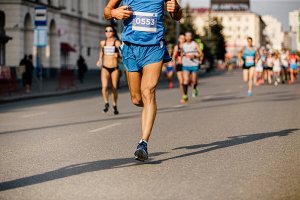Running Economy: Why is it so Important?

These days, running is a really popular way of exercising, but many people don’t actually know much about the technical elements of running. Running economy is something that very few runners know about, and yet, it’s key for achieving your optimal performance.
But, what is running economy?
Running economy is defined as the amount of oxygen that your body needs in order to maintain a certain speed while running. Obviously then, you can see why this might be an important factor in your running performance.
However, running economy will be different for long-distance and short-distance runners. The longer you intend to run, the more important a role your running economy will play in your performance.
In fact, together with your VO2 max and lactate threshold, running economy can be a useful predictor of an athlete’s performance in long-distance races.
What factors play a part in running economy?
Firstly, we need to separate these variables into intrinsic and extrinsic factors:
Extrinsic factors
In this case, these are all those variables external to the athlete and part of the environment. The most common are:
- Climate and temperature.
- Sports equipment: largely footwear in this case.
- The terrain, as well as location, with particular focus on elevation above sea level.
- Aerodynamic factors but to a lesser extent.

Intrinsic factors
These variables concern solely the athlete’s own physiology:
- Neuromuscular aspects, such as the type of muscle fiber.
- Metabolic factors
- Biomechanical aspects, such as their stride or posture.
- Physiological and anthropometric values, such as age, height, etc.
Is it easy to measure my running economy?
When it comes to measuring your running economy, there are various methods. These tests allow you to find out your VO2 max levels, which is one of the best predictors of performance.
The most complex method, and also somewhat more expensive, would be a stress test. If we add a gas exchange analysis to that, the results will be much more accurate.
However, in most cases, people won’t have the means to do this. Therefore, you can choose one of the following tests, which will give you some estimated values:
- Beep test, consisting of running 20 meters to reach a line before a beep is heard. The runner then runs back and tries to get back before the beep sounds again. This is repeated until the runner can run no more with the time between beeps getting shorter each time.
- Cooper test, consisting of running the maximum possible distance in a 12-minute period.
How to improve my running economy?
You can improve your running economy by looking at five key training strategies: endurance, strength, flexibility, altitude training, and finally, nutrition. We’ll look at each one separately.
Strength training
Strength will be an important factor in improving your running economy. You’ll need to focus heavily on your legs to improve muscle coordination and activation.
To do this, the most effective method is to work high loads at a very high speed. In this case, explosive training is the best choice, as shown by Berryman.
Endurance training
If you do some good endurance training, your metabolism and the cardiorespiratory system will be more efficient which will greatly improve your running economy.
As you perform this type of training, your body will adapt and your muscles’ ability to use oxygen will improve.
HIIT training, as well as hill work, will help to improve your VO2 max and therefore, improve your running economy.

Flexibility training
You’ll also need to have good flexibility in your joints, particularly your legs and hips. To do this, you’ll have to work all the muscle groups that contribute to the stability of the pelvis.
The psoas and hamstring will also need to be very flexible, whilst the muscle-tendon structures in the ankles and knees should be quite rigid.
Altitude training
When training at altitude, the body adapts and changes in the way it uses and distributes oxygen. All of this is positive for your running economy.
Nutrition
Finally, nutrition plays an important role in running economy. You’ll want to make sure that you get a good amount of nitrates, such as those that can be found in beetroot juice. The benefits of this are largely the saving of ATP (Adenosine triphosphate) during muscle contraction, which decreases oxygen consumption at the same time.
As you can see, running economy is a really important factor in your running performance. With the right training and nutrition, you’ll be able to run much more efficiently and get even closer to your running goals!
These days, running is a really popular way of exercising, but many people don’t actually know much about the technical elements of running. Running economy is something that very few runners know about, and yet, it’s key for achieving your optimal performance.
But, what is running economy?
Running economy is defined as the amount of oxygen that your body needs in order to maintain a certain speed while running. Obviously then, you can see why this might be an important factor in your running performance.
However, running economy will be different for long-distance and short-distance runners. The longer you intend to run, the more important a role your running economy will play in your performance.
In fact, together with your VO2 max and lactate threshold, running economy can be a useful predictor of an athlete’s performance in long-distance races.
What factors play a part in running economy?
Firstly, we need to separate these variables into intrinsic and extrinsic factors:
Extrinsic factors
In this case, these are all those variables external to the athlete and part of the environment. The most common are:
- Climate and temperature.
- Sports equipment: largely footwear in this case.
- The terrain, as well as location, with particular focus on elevation above sea level.
- Aerodynamic factors but to a lesser extent.

Intrinsic factors
These variables concern solely the athlete’s own physiology:
- Neuromuscular aspects, such as the type of muscle fiber.
- Metabolic factors
- Biomechanical aspects, such as their stride or posture.
- Physiological and anthropometric values, such as age, height, etc.
Is it easy to measure my running economy?
When it comes to measuring your running economy, there are various methods. These tests allow you to find out your VO2 max levels, which is one of the best predictors of performance.
The most complex method, and also somewhat more expensive, would be a stress test. If we add a gas exchange analysis to that, the results will be much more accurate.
However, in most cases, people won’t have the means to do this. Therefore, you can choose one of the following tests, which will give you some estimated values:
- Beep test, consisting of running 20 meters to reach a line before a beep is heard. The runner then runs back and tries to get back before the beep sounds again. This is repeated until the runner can run no more with the time between beeps getting shorter each time.
- Cooper test, consisting of running the maximum possible distance in a 12-minute period.
How to improve my running economy?
You can improve your running economy by looking at five key training strategies: endurance, strength, flexibility, altitude training, and finally, nutrition. We’ll look at each one separately.
Strength training
Strength will be an important factor in improving your running economy. You’ll need to focus heavily on your legs to improve muscle coordination and activation.
To do this, the most effective method is to work high loads at a very high speed. In this case, explosive training is the best choice, as shown by Berryman.
Endurance training
If you do some good endurance training, your metabolism and the cardiorespiratory system will be more efficient which will greatly improve your running economy.
As you perform this type of training, your body will adapt and your muscles’ ability to use oxygen will improve.
HIIT training, as well as hill work, will help to improve your VO2 max and therefore, improve your running economy.

Flexibility training
You’ll also need to have good flexibility in your joints, particularly your legs and hips. To do this, you’ll have to work all the muscle groups that contribute to the stability of the pelvis.
The psoas and hamstring will also need to be very flexible, whilst the muscle-tendon structures in the ankles and knees should be quite rigid.
Altitude training
When training at altitude, the body adapts and changes in the way it uses and distributes oxygen. All of this is positive for your running economy.
Nutrition
Finally, nutrition plays an important role in running economy. You’ll want to make sure that you get a good amount of nitrates, such as those that can be found in beetroot juice. The benefits of this are largely the saving of ATP (Adenosine triphosphate) during muscle contraction, which decreases oxygen consumption at the same time.
As you can see, running economy is a really important factor in your running performance. With the right training and nutrition, you’ll be able to run much more efficiently and get even closer to your running goals!
All cited sources were thoroughly reviewed by our team to ensure their quality, reliability, currency, and validity. The bibliography of this article was considered reliable and of academic or scientific accuracy.
- Barnes, K. R., & Kilding, A. E. (2015). Strategies to improve running economy. Sports Medicine, 45(1), 37-56.
- Berryman, N., Maurel, D., & Bosquet, L. (2010). Effect of plyometric vs. dynamic weight training on the energy cost of running. Journal of Strength and Conditioning Research, 24(7), 1818-1825.
This text is provided for informational purposes only and does not replace consultation with a professional. If in doubt, consult your specialist.








